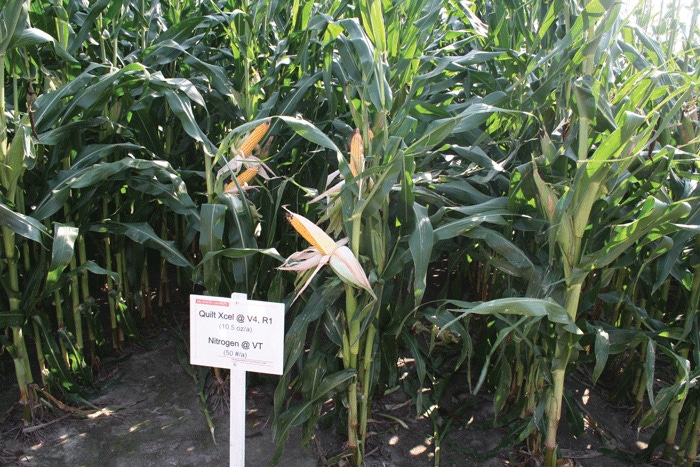
North Carolina Hula 400 corn tests results in big yields
• “Our focus was trying to increase kernel weight, because that looks like the best way to get to these 300 bushel and higher yields.”• “We did this in the tests at Northeast Ag Expo by increasing nitrogen to the plant at key growth periods.”
March 11, 2013

Virginia grower David Hula made big news in 2011 when we won the corn yield contest with 429 bushels of corn per acre.
Last year North Carolina State Corn Specialist Ronnie Heiniger set out to duplicate Hula’s feat with a test he calls Hula 400.
The Hula 400 test plots were part of the annual Northeast (North Carolina) Agricultural Expo. The 2011 show was held in Pasquotank County with cooperating farmer Charles Gray and his two sons.
Heiniger says, “Our focus was trying to increase kernel weight, because that looks like the best way to get to these 300 bushel and higher yields. We did this in the tests at Northeast Ag Expo by increasing nitrogen to the plant at key growth periods.”
David Hula, Kip Cullers and other growers with multiple yield championships in their resumes like to say, “A standing crop should never have a bad day.”
Heiniger says that principle drove some of the treatments in the Hula 400 tests. “We wanted to influence photosynthesis by increasing nitrogen content and thus chlorophyll content in the leaf at critical times in the plant’s growth cycle,” Heiniger says.
Though the North Carolina State research team didn’t quite make the 400 bushel per acre goal, they did grow some impressive corn, which was the talk of the mid-summer Expo.
The top yield of 324 bushels per acre came from adding nitrogen to corn just before tassling and before silking — much the same treatment as David Hula used to produce his record breaking crop in Virginia.
When growers apply nitrogen to corn at the V-7 stage, which is common in the Upper Southeast, often all the nitrogen is gone by the time the crop gets to the tassle stage and frequently it’s gone by the time grain fill begins, the North Carolina State specialist says.
Getting nitrogen to the plant at these later stages of development is the problem. By that time corn plants are tall and leaves have lapped across the rows, so making ground application is risky and most likely counter-productive to high yields.
The old-fashioned way
“We applied nitrogen at these later stages of growth the old fashioned way — with a hand sprayer, which is ideal for a small plot demonstration, but of course not practical in commercial production,” Heiniger says.
“However, nitrogen can easily be put on through irrigation equipment, and in most years to reach these ultra high yields in the Southeast, a grower is going to have to have irrigation,” he adds.
Al Wood, veteran Extension agent in Pasquotank County says 2012 might not have been the best year to seek ultra high yields because growing conditions were so good throughout the growing season.
“Yields at this site were outstanding across the board, and I think there are three compelling reasons for these high corn yields: Rain was constant throughout the growing season, including 15 inches in May, which may have restricted light needed for ultra high yields; the soil is outstanding — six foot deep topsoil; and the previous crop was cabbage, which left a good residual supply of fertilizer,” Wood says.
In addition, he adds, “Charles Gray and his sons are outstanding farmers, so everything was done just like we asked them to do it.”
The top yield in the Hula 400 test started out with planting a hybrid with high yield potential. In this case Pioneer 1615 corn was planted.
A double application of starter fertilizer was applied, using 3-18-18 at five gallons per acre in the furrow and a 2X2 application of 11-37-0 to supply a total of 40-50 pounds of nitrogen and 70 pounds or so of phosphorous in the front end of the plant to get it up and growing vigorously.
At side-dress a weed control herbicide was applied along with more nitrogen and even more nitrogen was applied at tassle.
The North Carolina researchers also used the extra nitrogen in combination with two fungicide applications and also tested the dual fungicide without the extra nitrogen.
“We got a good response from the extra nitrogen and we got a good response from the two fungicides. We thought we would get an extra yield bounce from a combination of the nitgrogen and fungicides, but that didn’t happen—neither of the treatments alone was equal to the combination,” Heiniger says.
Though the tests were designed to simulate David Hula’s record 429 bushel per acre corn yield, it wasn’t exactly the same.
Hula, who farms near Charles City, Va., on land that has been cultivated since the 1700s, says nitrogen timing is an important part of an overall system he uses to grow high yielding corn, but other factors are involved.
One key for Hula is the concept of ‘never-till’. “We don’t till anything and haven’t for a long time. By creating what we call a ‘high yield environment’ that includes intensive soil tests, tissue analysis, foliar nutrient applications and adding micronutrients where needed and not tilling our corn ground, we have doubled our organic matter over the past few years,” Hula says.
Hula tweaks nitrogen
For corn acres, Hula tweaks nitrogen a bit from year to year and field to field, but his basic program consists of injecting 60 pounds per acre of liquid nitrogen as a starter fertilizer, applied two inches beside and three inches below the seed row. To give corn plants an added boost, they apply 1-18-18, or a similar formulation at planting.
When corn is at the four leaf stage, they apply about a pound of nitrogen per acre for every bushel of yield they hope to harvest from the field. Often, in higher producing soils, that means side-dressing twice.
Like what you’re reading? Subscribe to Southeast Farm Press Daily and get the latest information right to your inbox!
Hula, who has competed in National Corn Growers Association yield competitions since the late 1990s also looks for new technology to bolster yields. His record breaking 2011 crop included two products, Bio-Forge and X-Tra Power from Stoller Chemical Company to stimulate root growth.
Heiniger has tested the Stoller products as well and says they may have a place in high yielding corn efforts. In the Northeast Ag Expo tests, or the Hula 400 tests, these products were not part of the project.
One thing the North Carolina State research team did try was a radical theory of defoliating corn plants from the tassle to the ear leaf. The idea, Heiniger says, is to get more sunlight to the plant at the ear leaf level and drive photosynthesis. The basic idea is to get more sugar from the ear leaf to the kernel, he says.
In addition to looking odd, the procedure had an adverse effect on yield. “It did give us some important information on the value of photosynthesis to high yielding corn, but in fact this treatment yielded about 40 bushels per acre less than the check plots in the test.
Combined, all the tests we did at the Northeast Ag Expo last year demonstrates the capability North Carolina corn growers have to grow high yielding crops. We did everything right in all the tests, even the check plots, and as a result most of the corn grown there was in the 300 bushel per acre range, Heiniger says.
Even with high input costs in the $490 per acre range, corn at current prices and yields of 300 bushels per acre can mean big money for our farmers,” he adds
You might also like:
Peanut research seeks ways to improve efficiency, cut costs
Bees next big big battleground for ag pesticides
Commentary: On-farm technology now sits in the palm of your hand
Southern agriculture gets legislative boost
About the Author(s)
You May Also Like





